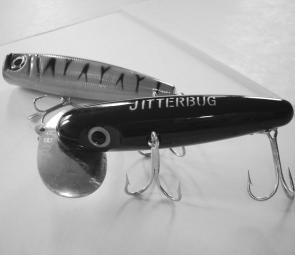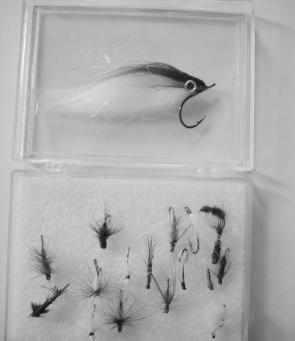March heralds the opening of the NSW deer hunting season. I’ve recently sighted in my new bow and, with plenty of black powder for the muzzle-loader, I’m looking forward to a busy month. The spread of wild deer throughout the State has been massive in the last ten years and whether I’m chasing cod in the western gorges, trout on the Tablelands or bass east of the Divide, encounters with wild deer are not uncommon.
Back in early January I took a quick visit to Khancoban Pondage in the heart of the Snowy Mountains. On the first evening I managed to pull a cracking 1.5kg brown trout from the froth and foam below the dam wall on a Badger Matuka. A couple of small rainbows and a midget redfin rounded out the excursion.
Next morning, before daylight I was sneaking down along the shore of the lake trying to spot a trout or two working the shallows. As I rounded a clump of poplars I noticed an animal standing amid the timber about 100m away. After stalking closer I managed to identify four red deer, a spiker with two hinds and a calf. It was a great treat and I watched the animals filter away into the brush as the dawn filtered over the ranges.
That’s one of the terrific joys about heading bush for a fish – if you keep your eyes open there’s plenty see. Other than skills of observation, 30 years of stalking have taught me how to hunt, a skill that greatly increases my fishing success as well.
While I’ve touched on it in other columns, the ability to ‘hunt’ is a necessity for angler success, especially in fresh water. While the blue-water and estuary anglers target tide fluctuations and habitat, the freshwater angler generally deals with fish that are more sedentary.
That means we really need to be able to identify places where fish station themselves and often it may only be a metre difference between productive and unproductive water.
Anglers have two choices – just like the hunter’s armoury. You either carry a shotgun or a rifle. The scattergun approach involves casting to everything, pounding the water with numerous casts in the hope that sooner or later you’ll hit the mark. Alternatively, the single shot aficionado will patiently stalk the stream, picking the eyes out of the watercourse and targeting areas of probable result.
The next couple of months are my favourites for Tablelands trout. The cooling conditions coupled with good stream flows mean Autumn trout really get going up this way.
Over March and into April expect some great mayfly hatches, particularly on the Wollomombi system. Generally the mayfly here are small and black so spinners around size 14 or even 16 are a great option.
Fish aren’t too fussy once the evening rise kicks off and a great back-up fly is a hopper pattern. Summer wasn’t that long ago and the resident trout still know a ‘works burger’ when they see one.
Out in the east, Ebor will be fishing terrifically. The tremendous stream flows which were constant all Summer have kept this area in top form.
On the faster eastern waters, stick to Humpies and perhaps a trailing nymph.
If the waters are well up, a bead-head Woolly Bugger around size 10 is the go. Don’t worry too much about colour, just make sure the fly is in contact with the bottom.
On short drifts in the turbulent water, ‘hop’ the steamer through with the rod tip.
As the cooler conditions approach now is also a great time to hit the local trout lakes. Over recent issues I’ve given a low-down on most of the private impoundments so follow those up.
The midge hatches tend to become more prolific so fly anglers would be well advised to pack some midge pupa patterns as well as the like of small Red Tags and Parachute Duns.
Don’t forget Dumaresq Dam near Armidale or, further south, Sheba Dams above Nundle. Both hold some great rainbows and offer a free shot at local trout.
Spin anglers will find small Tassie Devils in the brighter colours, pink being a favourite, will come into their own over the next couple of months. In the larger streams and lakes these will work a treat as the fish become active to put on condition.
Autumn is also a terrific time to start hard on the native species. Reports of excellent cod continue to get about and I expect the next month to produce some crackers, particularly at Copeton.
I’ve been getting my fair share of flyrod cod this Summer, mostly around 5kg, but now is the time to get after the big boys.
Before the first frosts hit you cannot go wrong with big surface lures. I know lots of folk reckon the mercury has to be boiling for the best popper activity but don’t you believe it.
The key in the cooler periods is to fish slowly, slowly, slowly! I prefer ‘slider’ style surface lures which have the bulk but don’t create quite as much surface disturbance. Another great cooler month lure is the old Jitterbug. Work these things at snail’s pace around the weed beds and shallows on dusk and at first light.
East of the ranges, the bass continue to put on a show. Some excellent fish have been taken in the lower Macleay River all Summer and from Georges Junction upstream you won’t have much problem finding them.
I recently enjoyed a couple of nights’ backpacking into the upper gorges for some respectable fish in the mid 30cm range. Shallow-running minnow patterns proved to be the key on that jaunt with Rapala CD-3s in brown trout pattern taking most fish.
On the lake front, Autumn yellowbelly have traditionally been a popular target throughout the North West. Keepit Dam has put on some weight following the Summer rains and some solid goldens have been responding to natural baits such as yabbies.
As the water cools, you’ll probably do better working hardbodies or soft plastics adjacent to the rock walls or heavy drowned timber. Such areas tend to hold the heat into the evening and you’ll often find the baitfish sitting tight against such cover.
The next couple of months offer pleasant and productive conditions throughout the New England region. I’ve got a fair few hills and gullies to search over the coming weeks as the countryside echoes to the roars of red stags and fallow bucks. But be assured, I’ll be wetting a line as well because it’s going to be that good.
Reads: 3400
Big and slow lures are the way to keep the surface action happening for Autumn cod.

Smaller fly patterns are the go for trout over the next couple of months. The polar fibre minnow shows the difference.




